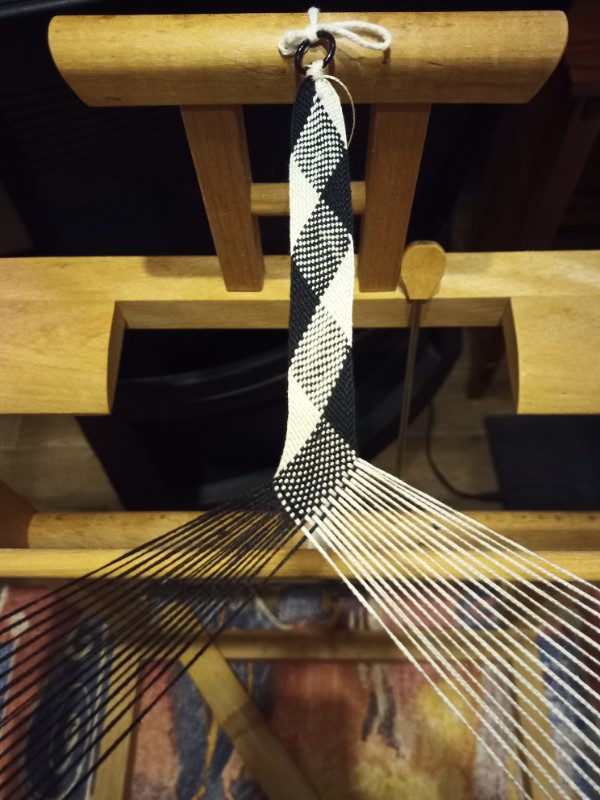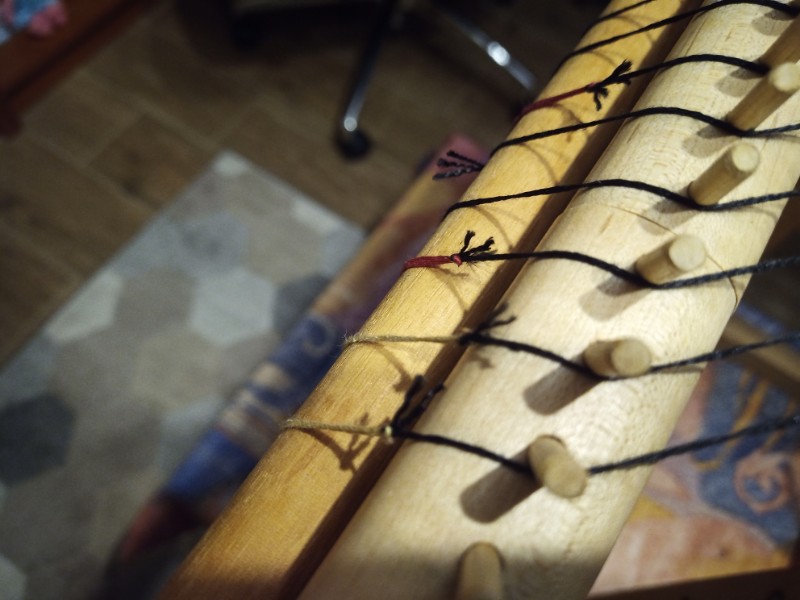I have been meaning to acquire a takadai braiding stand for years. They can be expensive, so I have been waiting until I decided that I was getting bored with marudai braiding, then I would probably make one. Braiding teacher Shirley Berlin broke the news to me several months ago that I would never really get bored of marudai kumihimo.
More recently, a friend of ours decided that she was ready to get rid of some surplus braiding equipment. She asked me if I knew anybody who was looking to buy a takadai, and quoted me a very good price.
So, I decided to bite the bullet and get started. Once I got it assembled, it looked like this:
The piece of bamboo resting diagonally across the lower arms is the beater sword used to tap stitshes into place. The pegs on the left and right upper arms are mounted in koma that slide along slots in the arms. At the top of the takadai is the tori. Lower down is the roller and standing vertically is the long metal pin that secures the roller.
To set up the takadai, you measure out a sufficient length of material and a sufficient number of threads of material for your braid. The definition of “sufficient” will vary based on the braid you are trying to make and the material you are using. (I measured out 34 55″ long threads of white 30/2 silk yarn and 32 55″ threads of black.) Then you tie a leader cord to the roller, pass it up over the tori, and tie it to the gathered end of your material. Then you separate out threads of material and wrap most of it around tama bobbins. (I wrapped two threads on each tama, so 17 white and 16 black.) Lastly, you hang strands over the koma, one tama per peg, on both arms of the takadai. (I started with all the white strands on the right, and all the black strands on the left.
To work a braid on this setup, you create a “shed” on one side of takadai by pushing some threads down. (I was making a simple weave braid, so my pattern was just alternating over (down) and under (up).) Then, you wedge the sword into the takadai so that it holds the shed open. Next, you pass the topmost strand from that side through the shed, and make it the bottommost strand on the other side. While you remove the sword and close the shed, use the sword to beat the point of braiding and tighten the braid. Repeat this process on the other side. Keep repeating this side to side and a braid will start to form.
When a koma at the top of an arm is empty, move it to the bottom of that arm and slide the other koma upwards. If a tama is getting to close to the arm, unwrap it six or seven inches. If the point of braiding is no longer over the round stick that holds the sword down, crank the roller a little to wind up the leader.
Eventually, the braid will get long enough to wrap around the roller itself. Keep going. By this point, I was doing one full iteration (with the material returning to start position) about every forty minutes, making about 2.5 inches of braid.
After even more time, the tama leaders will start to peep up over the edge of the koma. Now you are in the home stretch, but you are far from the finish line. Keep going until you are almost out of material.
My braid came out 25 inches long and about an inch wide. You can see how the black and white strands pass back and forth through each other and themselves. Not bad for a first braid!








A very good beginning.
Thank you!
That’s as neat as a pin! great effort- I suppose it’s kind of like an inkle loom but a bit different at the same time. Is it particularly quick to weave?
Inkle is weaving. You have separate warp threads and weft threads.
Takadai kumihimo is braiding. Threads take turns being both warp and weft.
It’s not particularly fast for me, but I am not good at it (yet).
There are some braids that are difficult to make without a takadai, though.